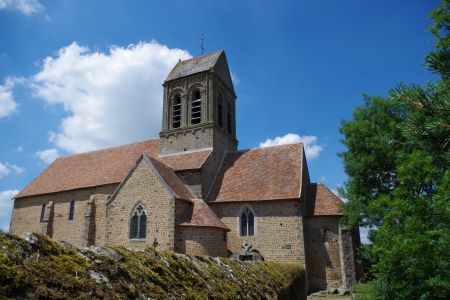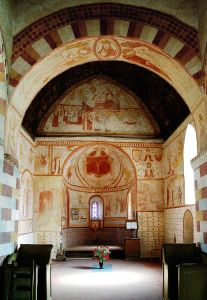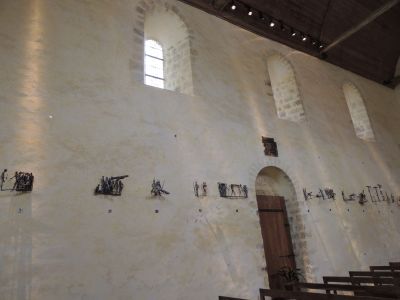Church | 1089 | Romanesque | Catholic Church

Map
Opening hours
01 January - 31 December
Mon 10.00 - 18.00
Tue 10.00 - 18.00
Wed 10.00 - 18.00
Thu 10.00 - 18.00
Fri 10.00 - 18.00
Sat 10.00 - 18.00
Sun 10.00 - 18.00
Description
The transept, choir, apse and apses of the church were built between 1089 and 1124 on this original site, as evidenced by several sarcophagi. The square-plan tower with a gabled roof resting on four massive piers joined by semicircular arches and the nave were built later.
Major works were undertaken in the 19th century, including the restoration of the nave facade and the opening of ogee windows, which have now been rebuilt.
The church is best known for its wall paintings, discovered in the 1850s by Abbé Retours, who spotted traces of them under the whitewash. They were uncovered and ‘restored’ between 1857 and 1862 by Pierre Honoré Chadaigne, a painter from Alençon, who repainted and sometimes invented, as was the custom at the time. Several layers were superimposed, dating from the 12th to the 15th century. The church has been listed as a Historic Monument since 1886.
Translated with www.DeepL.com/Translator (free version)
Photos
Remarkable elements
Honeycomb
As you walk around the church, which offers spectacular views of the surrounding countryside, you will discover a bees' nest on the south side of the chancel. According to legend, in 898, the soldiers of Charles III the Simple, King of France, who were occupying the region, were disrespectful towards the church. They were attacked by bees, and to escape the stings, the soldiers fell from the cliff. The church has been home to bees ever since.
Translated with www.DeepL.com/Translator (free version)
Way of the Cross
Sculpted in an alloy of lead and silvered pewter, it was donated in 2001 by Christian Malézieux (1931-2024), a painter and sculptor based in the village. The human body is one of his favourite themes, and he depicts the suffering body of Christ during his passion with force and economy of means.
Gothic vault
In 1986, the removal of the choir's plaster vault revealed the old 13th-century stave-wood vault with its painted decoration of angel musicians set in quatrefoils.
Translated with www.DeepL.com/Translator (free version)
Virgin with cloak
Born of a monk's vision, the image of the Virgin with her cloak became widespread in the 14th century. Mary, very tall and upright, opens the sides of her cloak, sheltering a number of figures. The emphasis is on the Virgin's protective role, always coming to the aid of suffering humanity, a very popular theme at the time of the plague epidemics. Extensively restored by Chadaigne, this scene is so emblematic that Christian Malézieux has reinterpreted it in a painting that adorns the walls of the town hall.
Translated with www.DeepL.com/Translator (free version)
The Holy Face
This painting has been precisely dated to between 1370 and 1384, thanks to the coats of arms: those of Pope Urban V and those of Louis 1st of Anjou. The standing man wearing the tiara probably represents the Pope. He is holding up the cloth with Christ's face printed on it. It was Urban V who gave permission for the Holy Face to be displayed for the veneration of the Roman faithful. This painting is therefore contemporary with the introduction of a new devotion.
Translated with www.DeepL.com/Translator (free version)
Christ in majesty
In the lower register, the apse is decorated with episodes from the life of Saint Ceneri, crowned by Christ in majesty in a mandorla, a kind of almond-shaped halo. Around him are the winged figures of the Tetramorph, the animals of the Apocalypse that have become the symbols of the Evangelists. This scene illustrates the glorious return of Christ at the end of time, and is traditionally painted on the vault because it offers a vision of the open sky.
Translated with www.DeepL.com/Translator (free version)


















